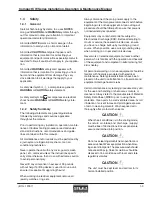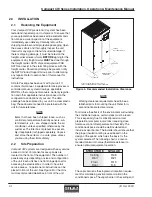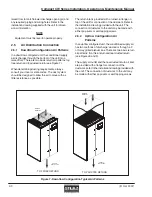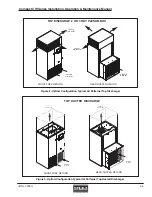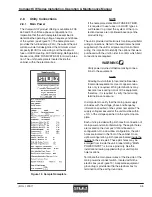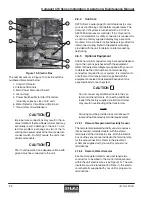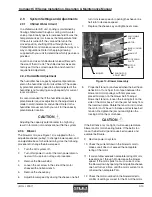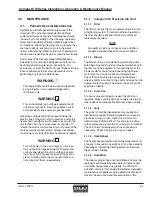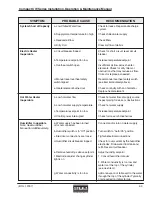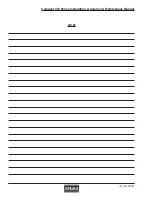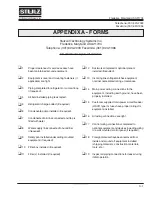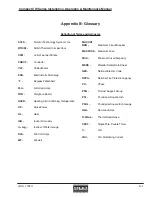
(© Oct, 2007)
Compact CW Series Installation, Operation & Maintenance Manual
Air Technology Systems, Inc.
4-1
4.0
MAINTENANCE
4.1
Periodic General Maintenance
Systematic, periodic general maintenance of the
Compact CW unit is recommended for optimum
system performance. General maintenance should
include, but is not limited to the following: replacing
filters and humidifier cylinders, tightening electrical
connections, checking the water lines to ensure they
are free of debris, ensuring no air is in the water
line(s), cleaning the interior of the unit, checking belt
tension and inspecting the unit’s components visually.
Use copies of the Periodic General Maintenance
Checklist in this manual (see Appendix A) to record
periodic general maintenance inspections. For
assistance, contact the SATS Product Support Group.
Ensure adherence to all safety statements while
performing any type of maintenance.
WARNING
This equipment should be serviced and repaired
by a journeyman or a qualified refrigeration
technician only.
WARNING
This unit employs high voltage equipment with
rotating components. Exercise extreme care to
avoid accidents and ensure proper operation.
Hazardous voltage will still be present inside the
electric box at the motor start protectors and at the
heater and humidifier circuit breakers, even with the
unit turned off at the microprocessor controller. To
isolate the unit for maintenance, turn off power at the
main power disconnect switch. Always disconnect
main power prior to performing any service or repairs.
WARNING
Turn off power to the unit unless you are per-
forming tests that require power. With power and
controls energized, the unit could begin operat-
ing at any time. To prevent personal injury, stay
clear of rotating components as automatic con-
trols may start them unexpectedly.
4.1.1
Compact CW Precision A/C Unit
4.1.1.1 Filter
The filter is usually the most neglected item in an air
conditioning system. To maintain efficient operation,
the filter should be checked at least monthly and
replaced as required.
NOTE
Air quality conditions of spaces vary and filters
should be checked based on those conditions.
4.1.1.2 Blower
The blower motor is provided with permanently lubri-
cated bearings and should not require maintenance for
the lifetime of the equipment. Periodic checks of the
blower system should include checking the blower
motor mounts, housing, belts and blower wheel.
Check that all mounts are secure and the blower
wheel is tightly mounted on the shaft and does not rub
against the fan housing. The blower vanes should be
kept free of debris.
4.1.1.3 Drain Pan
To ensure proper drainage, inspect the drain pan
regularly. Make sure the drain pan outlets are always
free of debris and ensure the drain pan does not leak.
4.1.1.4 Coils
The coil(s) should be inspected semi-annually and
cleaned as required, following standard coil cleaning
practices. Using a brush, clean the coil fins of all
debris that will inhibit airflow. This can also be done
with compressed air or with a commercial coil cleaner.
Check for bent or damaged coil fins and repair as
necessary. Check all piping for signs of leaks.
4.1.1.5 Heat/Reheat
The heat/reheat equipment should be inspected semi-
annually to ensure it is operational. If you have electric
heat/reheat, inspect the heating elements to ensure
they are free of debris.
4.1.1.6 Humidifier
The steam cylinder has a limited lifetime and must be
replaced periodically. Because water conditions and
humidifier usage rates vary greatly, it is difficult to
establish intervals for changing the cylinder. Individual
maintenance schedules must be determined for each
location, based upon periodic examination of the

